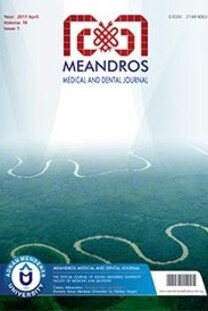ADNAN MENDERES ÜNİVERSİTESİ YENİDOĞAN YOĞUN BAKIM ÜNİTESİ'NDE İZLENEN BEBEKLERDE DOĞUMSAL KALP HASTALIĞI SIKLIĞI
Yenidoğan, doğumsal, kalp hastalığı
The Prevalence of Congenital Heart Disease in Newborns at Adnan Menderes University Neonatal Intensive Care Unit
Newborn, congenital, heart disease,
___
- 1. Flanagan MF, Yeager SB, Weindling SN. Cardiac disease. In: MacDonald MG, Seshia MMK, Mullet MD,editors. Avery's Neonatology Pathophysiology and Management of the Newborn, 6th ed. Lippincott, Williams andWilkins, Philadelphia, 2005: 633-709.
- 2. Bernstein D. Epidemiology and genetic basis of congenital heart disease. In: Behrman RE, Kliegman RM, Jenson HB, editors. Nelson Textbook of Pediatrics, 17th ed. Saunders, Philadelphia, 2004: 1499-1502.
- 3. Hoffman JI. The incidence of congenital heart disease: II. Prenatal incidence. Pediatr Cardiol 1995; 16: 155- 65.
- 4. Hoffman JI, Kaplan S. The incidence of congenital heart disease. JAm Coll Cardiol 2002; 39: 1890-900.
- 5. Güven H, Bakiler AR, Kozan M, Aydınoğlu H, Helvacı M, Dorak C. Echocardiographic screening in newborn infants. Çocuk Sağlığı ve Hastalıkları Dergisi 2006; 49: 8-11.
- 6. Park MK. Manifestations of cardiac problems in the newborn. In: Park MK, editor. Pediatric Cardiology for Practitioners, 3rd ed. Mosby, St. Louis, 1996: 374-98.
- 7. Ainsworth SB, Wyllie JP, Wren C. Prevalence and clinical significance of cardiac murmurs in neonates. Arch Dis Child Fetal Neonatal Ed 1999; 80: F43-5.
- 8. Farrer KFM, Rennie JM. Neonatal murmurs: are senior house officers good enough? Arch Dis Child Fetal Neonatal Ed 2003; 88: F147-51.
- 9. Hoffman JI, Kaplan S, Liberthson RR. Prevalence of congenital heart disease. Am Heart J 2004; 147: 425- 39.
- 10. Park MK. Left-to-right shunt lesions. In: Park MK, editor. Pediatric Cardiology for Practitioners, 3rd ed. Mosby, St. Louis, 1996:145-6.
- 11. Reinhold-Richter L, Fischer A, Schneider-Obermeyer J. Congenital heart defects. Frequency at autopsy. ZentralblAllg Pathol 1987; 133: 253-61.
- 12. Meberg A, Otterstad JE, Frøland G, Sørland S. Children with congenital heart defects in Vestfold 1982-88. Increase in the incidence resulting from improved diagnostics methods. Tidsskr Nor Laegeforen 1990; 110: 354-7.
- 13. Abu-Sulaiman RM, Subaih B. Congenital heart disease in infants of diabetic mothers: Echocardiographic study. Pediatr Cardiol 2004; 25: 137-40.
- ISSN: 2149-9063
- Yayın Aralığı: 4
- Başlangıç: 2000
- Yayıncı: Aydın Adnan Menderes Üniversitesi
Muhammed Fatih ÖNSÜZ, Seyhan HIDIROĞLU
Süleyman Ayvaz AYDOĞDU, Münevver TÜRKMEN, Pınar ÖZKAN
PNÖMOSKROTUM: ÇİFT KONTRASLI KOLON GRAFİSİNİN NADİR BİR KOMPLİKASYONU (OLGU SUNUMU)
Aziz SÜMER, Güven TEKBAŞ, Sübet ÖZERDEM
GEBELERDE DOĞUM ve POSTPARTUM DÖNEME İLİŞKİN ENDİŞELER; BİR ÖLÇEK GELİŞTİRME VE VALİDASYON ÇALIŞMASI
Gül KİTAPÇIOĞLU, Emre YANIKKEREM, Ümran SEVİL, Derya YÜKSEL
KAYNAK YÖNETİMİ VE İLGİLİ BİLGİ TEKNOLOJİLERİ
Sadi Kerem OKUTUR, Cemal BES, Ayla Yıldız ERKAL, Gülçagrı EROL, Fatih BORLU
MİNÖR KÜNT TRAVMAYA BAĞLI DİYAFRAGMA RÜPTÜRÜ VE HERNİASYON
Oğuz HASDEMİR, Süleyman ÇETINKUNAR, Erol YALÇIN, Deniz GAZİOĞLU, Serra SOYLU
PARKİNSON HASTALIĞINDA OBSESİF KOMPULSİF BOZUKLUK
Tugba TUNÇ, Özlem COŞKUN, Gökhan ÖZER, Ufuk EMRE, Esra OKUYUCU, Serpil YANDI VARGEL, Levent Ertuğrul İNAN
PULMONER İNFLAMATUAR PSÖDOTÜMÖR
Ahmet Tuncay TURGUT, Uğur KOŞAR, Cüneyt KURUL, Salih TOPÇU, İrfan TAŞTEPE
NADİR BİR TORAKS TÜMÖRÜ: SİNOVYAL SARKOM OLGU SUNUMU VE LİTERATÜRÜN GÖZDEN GEÇİRİLMESİ
Ahmet Tuncay TURGUT, Ugur KOŞAR, Cüneyt KURUL, Salih TOPÇU, İrfan TAŞTEPE
